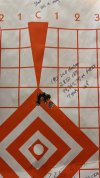Joefrazell
Well-Known Member
- Joined
- Apr 29, 2017
- Messages
- 1,599
okay I'll try make this more clear. It has nothing to do with chambering a round. They all chamber great. The neck once fired is expanding .003". There's definitely no significant neck tension once fired as I can insert a bullet by hand it's just a bit tighter then some of my other rifles. The lapua brass is thick and only allows .003 neck expansion. It's a mechanical ejector so it's not denting the neck as all. I am moving on to other things as my smith says .003 is enough clearance. I may try some adg brass as it's a few thousandths smaller in the neck diameter or possibly get the stuff to turn the necks down a few thousandths to be sure its not an issue. First I'm trying another bullet or two.

